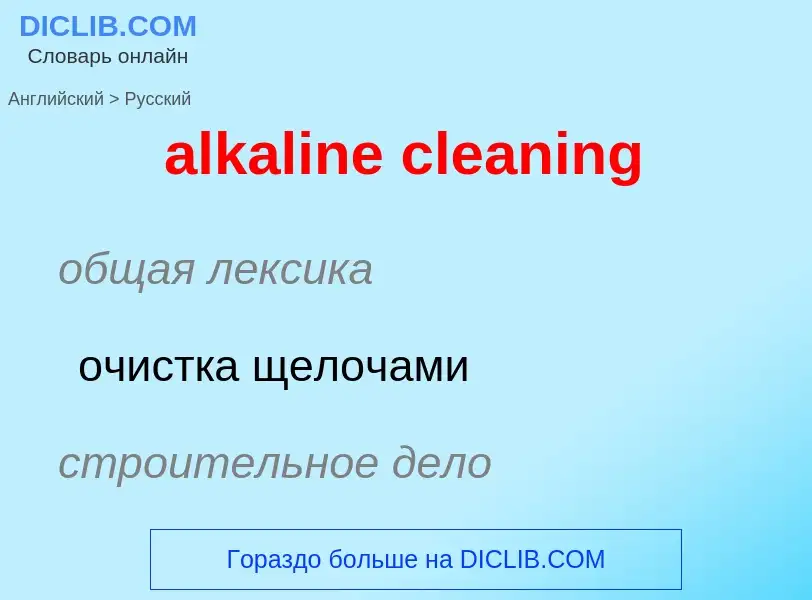Перевод и анализ слов искусственным интеллектом ChatGPT
На этой странице Вы можете получить подробный анализ слова или словосочетания, произведенный с помощью лучшей на сегодняшний день технологии искусственного интеллекта:
- как употребляется слово
- частота употребления
- используется оно чаще в устной или письменной речи
- варианты перевода слова
- примеры употребления (несколько фраз с переводом)
- этимология
alkaline cleaning - перевод на русский
общая лексика
очистка щелочами
строительное дело
очистка (декапирование) щелочными растворами
общая лексика
щелочная батарея
медицина
щелочная фосфатаза
строительное дело
щёлочноземельные металлы
общая лексика
детергент
моющее средство
смывочный раствор
Определение
Википедия

An alkaline battery (IEC code: L) is a type of primary battery where the electrolyte (most commonly potassium hydroxide) has a pH value above 7. Typically these batteries derive energy from the reaction between zinc metal and manganese dioxide, nickel and cadmium, or nickel and hydrogen.
Compared with zinc–carbon batteries of the Leclanché cell or zinc chloride types, alkaline batteries have a higher energy density and longer shelf life, yet provide the same voltage.
The alkaline battery gets its name because it has an alkaline electrolyte of potassium hydroxide (KOH) instead of the acidic ammonium chloride (NH4Cl) or zinc chloride (ZnCl2) electrolyte of the zinc–carbon batteries. Other battery systems also use alkaline electrolytes, but they use different active materials for the electrodes.
Alkaline batteries account for 80% of manufactured batteries in the US and over 10 billion individual units produced worldwide. In Japan, alkaline batteries account for 46% of all primary battery sales. In Switzerland, alkaline batteries account for 68%, in the UK 60% and in the EU 47% of all battery sales including secondary types. Alkaline batteries contain zinc (Zn) and manganese dioxide (MnO2) (Health codes 1), which is a cumulative neurotoxin and can be toxic in higher concentrations. However, compared to other battery types, the toxicity of alkaline batteries is moderate.
Alkaline batteries are used in many household items such as MP3 players, CD players, digital cameras, toys, flashlights, and radios.



![Several sizes of button and coin cells. Some are alkaline and others are [[silver oxide]]. Two 9 V batteries were added as a size comparison. Enlarge to see the size code markings. Several sizes of button and coin cells. Some are alkaline and others are [[silver oxide]]. Two 9 V batteries were added as a size comparison. Enlarge to see the size code markings.](https://commons.wikimedia.org/wiki/Special:FilePath/Button cells and 9v cells (3).png?width=200)
![nickel–iron batteries]] manufactured under the "[[Exide]]" brand, originally developed in 1901 by Thomas Edison used a potassium hydroxide electrolyte. nickel–iron batteries]] manufactured under the "[[Exide]]" brand, originally developed in 1901 by Thomas Edison used a potassium hydroxide electrolyte.](https://commons.wikimedia.org/wiki/Special:FilePath/Thomas Edison's nickel–iron batteries.jpg?width=200)



![[[Emerald]], colored green with trace amounts of [[chromium]], is a variety of the mineral [[beryl]] which is beryllium aluminium silicate. [[Emerald]], colored green with trace amounts of [[chromium]], is a variety of the mineral [[beryl]] which is beryllium aluminium silicate.](https://commons.wikimedia.org/wiki/Special:FilePath/Beryl-130023.jpg?width=200)
![[[Emerald]] is a form of beryl, the principal mineral of beryllium. [[Emerald]] is a form of beryl, the principal mineral of beryllium.](https://commons.wikimedia.org/wiki/Special:FilePath/Béryl var. émeraude sur gangue (Muzo Mine Boyaca - Colombie) 15.jpg?width=200)





